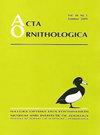Temporal Changes in Wing Length, Fat Reserves and Body Mass of Migrating Eurasian Blackcaps Sylvia atricapilla at a West Hungarian Stopover Site
IF 1.3
4区 生物学
Q3 ORNITHOLOGY
引用次数: 0
Abstract
Abstract. Changes in biometric characteristics of a migrating bird population at a given capture site could reflect that the migration strategies of the species may be changing. A robust data set (15,520 records) was used to analyse the changes in biometric characteristics of the Eurasian Blackcap Sylvia atricapilla in western Hungary between August and October during the study period (2001–2019). All age and sex classes displayed similar phenology of monthly captures and biometric change: the average wing length, fat score and body mass increased in the migrating population from August to October. This could be explained by changes in the morphometric distribution of different migrating populations, in later months more birds might arrive from a larger distance, primarily from the Baltic regions and the Czech Republic. The biometrics of juvenile birds captured in August did not change significantly from 2001 to 2019, while the wing lengths decreased and fat scores increased significantly between 2001 and 2019 in September and October in both sex classes. This could be explained by a change in the migration distance or different morphology of individuals from the north which stopped over at the study area. Due to the global warming and habitat changes in the last decade, the shorter migration route and favourable conditions at overwintering areas north of the Sahara or around the Mediterranean could favour Blackcaps which migrate a shorter distance.在西匈牙利的中途停留点,迁徙的欧亚黑头莺翅膀长度、脂肪储备和体重的时间变化
摘要在一个给定的捕获地点,候鸟种群的生物特征变化可以反映该物种的迁徙策略可能正在发生变化。在研究期间(2001-2019年),研究人员使用了一个强大的数据集(15520条记录)来分析8月至10月期间匈牙利西部欧亚黑帽Sylvia atricapilla生物特征的变化。不同年龄和性别的候鸟在月捕获和生物特征变化方面表现出相似的物候特征:8 - 10月候鸟的平均翅长、脂肪评分和体重增加。这可以用不同候鸟种群形态分布的变化来解释,在之后的几个月里,更多的候鸟可能从更远的地方飞来,主要来自波罗的海地区和捷克共和国。2001 - 2019年8月捕获的幼鸟的生物特征变化不显著,而2001 - 2019年9月和10月两个性别班级的翅长和脂肪得分均显著减少和显著增加。这可以解释为迁徙距离的变化或来自北方的个体在研究区域停留的不同形态。由于过去十年全球变暖和栖息地的变化,较短的迁徙路线和撒哈拉沙漠北部或地中海周围越冬地区的有利条件可能有利于黑头莺迁徙距离较短。
本文章由计算机程序翻译,如有差异,请以英文原文为准。
求助全文
约1分钟内获得全文
求助全文
来源期刊

Acta Ornithologica
生物-鸟类学
CiteScore
2.10
自引率
0.00%
发文量
14
审稿时长
>12 weeks
期刊介绍:
Publishes scientific papers (original research reports, reviews, short notes, etc.) and announcements from all fields of ornithology. All manuscripts are peer-reviewed.
Established in 1933 as Acta Ornithologica Musei Zoologici Polonici, since 1953 continued under the present title.
Published twice a year by the Natura Optima Dux Foundation under the auspices of the Museum and Institute of Zoology, Polish Academy of Sciences.
 求助内容:
求助内容: 应助结果提醒方式:
应助结果提醒方式:


